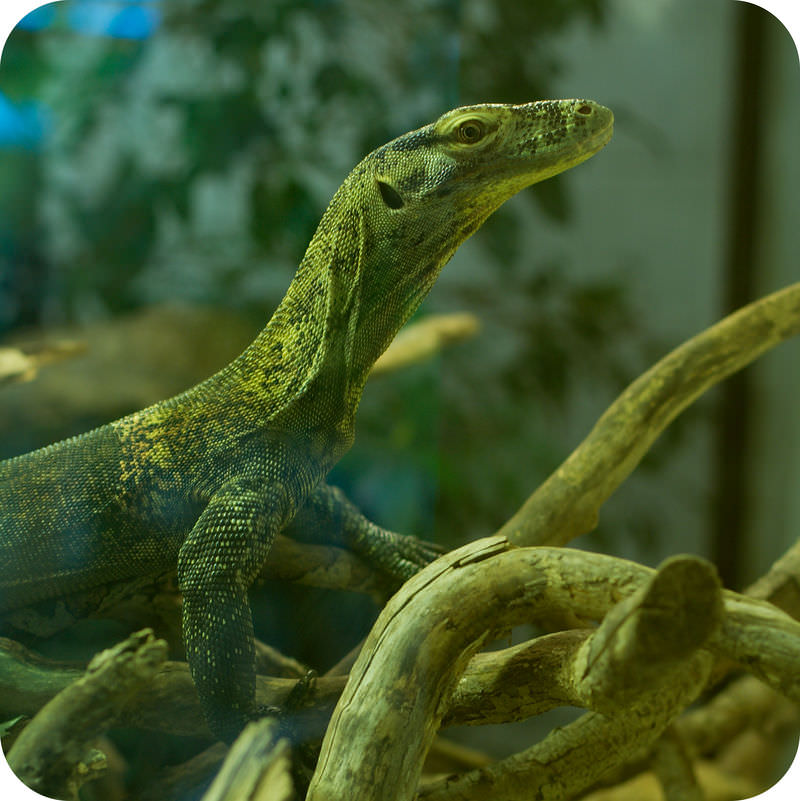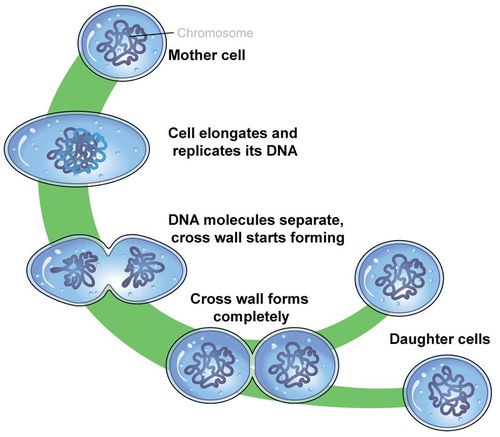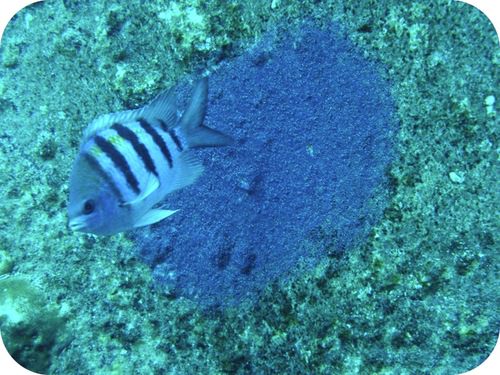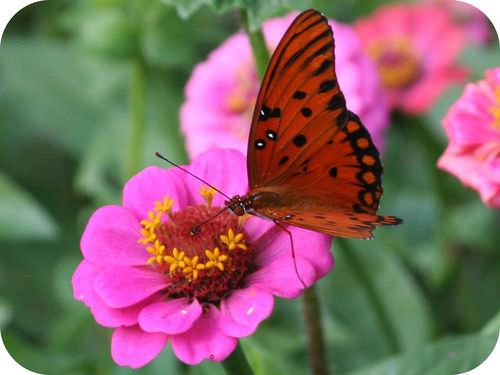2.22繁殖
章节大纲
-
Do animals always have two parents?
::动物总是有双亲吗?No, not all animals have two parents. When necessary, some animals can be produced from just one parent. Some , such as this Komodo dragon, have only one parent. The process of creating offspring from just one individual is called asexual reproduction .
::不,不是所有的动物都有双亲。必要时,有些动物只能由父母一方生产。有些动物,如科莫多龙,只有父母一方。从一个人创造后代的过程被称为性生殖。Reproduction
::复制复制Animals and other organisms cannot live forever. They must reproduce if their species is to survive. But what does it mean to reproduce? Reproduction is the ability to make the next generation, and it is one of the basic . Two methods of reproduction are:
::动物和其他生物不能永远生存下去。它们必须繁殖,如果它们的物种是生存的。但是繁殖意味着什么?繁殖是下一代的能力,是基本的方法之一。两种繁殖方法有:- Asexual reproduction , the process of forming a new individual from a single parent.
::性生殖,从单亲家庭中形成新人的过程。
- Sexual reproduction , the process of forming a new individual from two parents.
::性生殖,即父母双方组成新人的过程。
There are advantages and disadvantages to each method, but the result is always the same: a new life begins.
::每种方法都有利弊,但结果总是相同的:新的生命开始。Asexual Reproduction
::性生殖When humans reproduce, there are two parents involved. must be passed from both the mother and father to the child. Humans cannot reproduce with just one parent; humans can only reproduce sexually. But having just one parent is possible in other eukaryotic organisms, including some , , and reptiles. These organisms can reproduce asexually, meaning the offspring ("children") have a single parent and share the exact same genetic material as the parent. This is very different from reproduction in humans. Bacteria , being a prokaryotic, single-celled organism, must reproduce asexually.
::当人类繁殖时,必须有两个双亲。必须从父母双方传给孩子。人类不能只由父母一方繁殖;人类只能通过性繁殖。但只有父母一方在其它食气生物中是可能的,包括某些,和爬行动物。这些生物可以性繁殖,这意味着后代("子女")有一个单亲父母,并且拥有与父母完全相同的遗传物质。这与人类的繁殖非常不同。细菌是一种纯洁的、单细胞的有机体,必须具有性繁殖能力。The advantage of asexual reproduction is that it can be very quick and does not require the meeting of a male and female organism. The disadvantage of asexual reproduction is that organisms do not receive a mix of traits from both parents. An organism that is born through asexual reproduction only has the DNA from the one parent. In fact, the offspring is genetically an exact copy of the parent. This can cause problems for the individual. For example, if the parent has a gene that causes a particular disease, the offspring will also have the gene that causes that disease. Organisms produced sexually may or may not inherit the disease gene because they receive a mix of their parents' genes.
::性生殖的好处是,它可以很快发生,而且不需要与男女有机体会面。性生殖的不利之处在于,生物体没有从父母双方获得混合的特性。通过性生殖出生的有机体只有一方的DNA。事实上,后代的基因是父母的准确副本。这可能会给个人造成问题。例如,如果父母的基因造成某种疾病,则后代也会有导致这种疾病的基因。性生产的有机体可能或可能不会继承这种疾病基因,因为他们得到父母基因的混合。Types of organisms that reproduce asexually include:
::性繁殖的生物类型包括:- Prokaryotic organisms, like bacteria. Bacteria reproduce through binary fission , where they grow and divide in half ( Figure ). First, their chromosome replicates and the cell enlarges. The cell then divides into two cells as new membranes form to separate the two cells. After , the two new cells each have one identical chromosome. This simple process allows bacteria to reproduce very rapidly.
::细菌通过二进制裂变繁殖,二进制裂变中它们生长并分裂成两半(图 )。首先,它们的染色体复制和细胞扩大。然后细胞分成两个细胞,作为新的膜形式来分离这两个细胞。之后,两个新的细胞各有一个相同的染色体。这个简单的过程可以让细菌快速繁殖。
- , an invertebrate animal species. Flatworms divide in two, then each half regenerates into a new flatworm identical to the original, a process called fragmentation .
::一种无脊椎动物物种。 分为两部分, 然后每半个再生成一种与原始一样的新的单虫, 一种叫做碎裂的过程。
- Different types of insects, fish, and lizards. These organisms can reproduce asexually through a process called parthenogenesis . Parthenogenesis happens when an unfertilized egg cell grows into a new organism. The resulting organism has half the amount of genetic material of the parent. Parthenogenesis is common in honeybees. In a hive, the sexually produced eggs become workers, while the asexually produced eggs become drones.
::不同种类的昆虫、鱼和蜥蜴。这些生物可以通过一种叫“异种起源”的过程进行性繁殖。当一个未受精的蛋细胞成长为一个新的有机体时,就会发生分泌。由此产生的有机体的遗传物质量为母体的一半。在蜜蜂中,异种起源很常见。在蜂巢中,性产卵成为工人,而无性产卵成为无人机。
Bacteria reproduce by binary fission. Shown is one bacterium reproducing and becoming two bacteria. Sexual Reproduction
::性生殖During sexual reproduction, two parents are involved. Most animals are dioecious , meaning there is a separate male and female sex, with the male producing and the female producing eggs. When a sperm and egg meet during , a zygote , the of a new organism, is formed ( Figure ). This process combines the genetic material from both parents. The resulting organism will be genetically unique. The zygote will divide by and grow into the embryo .
::在生殖过程中,父母双亲都参与其中。大多数动物是二手的,意思是男女有分开的性别,男性生产和女性产卵。当精子和卵子在...期间相遇时,形成一个zygote,新生物体(图)。这一过程将父母双方的遗传材料结合在一起。由此产生的生物将具有独特的基因。zygote将分裂成胚胎,并成长为胚胎。During sexual reproduction, a sperm fertilizes an egg. Let's explore how animals, plants, and reproduce sexually:
::让我们探索动物、植物和性繁殖的方式:Animals often have gonads , organs that produce eggs or sperm. The male gonads are the testes , and the female gonads are the ovaries . Testes produce sperm; ovaries produce eggs. Sperm and egg, the two sex cells, are known as gametes , and can combine two different ways, both of which combine the genetic material from the two parents. Gametes have half the amount of the genetic material of a regular body cell; they are haploid cells. In humans, gametes have one set of 23 chromosomes. Gametes are produced through a special type of cell division known as . Normal human cells have 46 chromosomes. They are diploid cells, with two sets of 23 chromosomes (23 pairs).
::动物通常有果子、产卵或精子的器官。雄性腺是睾丸,雌性腺是卵巢。测试产生精子;卵子产卵。两个性细胞的精子和蛋被称为色素,可以结合两种不同的方式,这两种方式都结合了父母双方的遗传物质。甘特斯拥有正常身体细胞遗传物质的一半,它们是杂乱的细胞。在人类中,甘特斯有一套23种染色体。甘特斯是通过一种特殊类型的细胞分裂产出的。正常人细胞有46种染色体,它们是两套23种染色体(23对)。Fish and other animals release their gametes in the water, which is called external fertilization ( Figure ). These gametes will combine by chance. Animals that live on land (reptiles, , and mammals) reproduce by internal fertilization . Typically males have a penis that deposits sperm into the vagina of the female. Most birds don’t have penises, but they do have a chamber called the cloaca that they place close to another bird’s cloaca to deposit sperm. must live close to water as they must lay their eggs in a moist or wet environment prior to external fertilization.
::鱼类和其他动物在水中放出它们的卵子,也就是所谓的外部授精(图 ) 。 这些果子会因偶然而合并。 生活在陆地上的动物(松鼠和哺乳动物)通过体内授精繁殖。 通常雄性有一种阴茎,将精子嵌入雌性阴道中。 大多数鸟类没有阴茎,但是它们确实有一个叫Cloaca的室室,该室位于另一只鸟的木瓜附近,用来存放精子。 它们必须靠水过活,因为它们必须在外部授精之前在潮湿的环境中产卵。This fish guards her eggs, which will be fertilized externally. - Plants can also reproduce sexually, but their reproductive organs are different from animals’ gonads. Plants that have flowers have their reproductive parts in the flower. The sperm is contained in the pollen , while the egg is contained in the ovary, deep within the flower. The sperm can reach the egg two different ways:
::植物也可以在性方面繁殖,但其生殖器官与动物的鼻涕不同。 有花的植物在花中含有生殖部分。 精子存在于花粉中,卵子则存在于花卵中,而卵子则存在于花中深处。 精子可以两种不同的方式到达鸡蛋:
- In self- pollination , the egg is fertilized by the pollen of the same flower.
::在自污染中,卵受同一花朵的花粉的施肥。
- In cross-pollination , sperm from the pollen of one flower fertilizes the egg of another flower. Like other types of sexual reproduction, cross-pollination allows new combinations of traits. Cross-pollination occurs when pollen is carried by the wind to another flower. It can also occur when animal pollinators , like honeybees or butterflies ( Figure ), carry the pollen from flower to flower.
::在交叉授粉中,一朵花的花粉的精子使另一朵花的卵受精。与其他类型的性生殖一样,交叉授粉也带来了新的特质组合。当花粉被风吹到另一朵花上时,就会发生交叉授粉。当动物授粉者,如蜜蜂或蝴蝶(图),把花粉从花中传到花中时,也会发生交叉授粉。
Butterflies receive nectar when they deposit pollen into flowers, resulting in cross-pollination. - Fungi can also reproduce sexually, but instead of female and male sexes, they have (+) and (-) strains. When the filaments of a (+) and (-) fungi meet, the zygote is formed. Just like in plants and animals, each zygote receives DNA from two parent strains.
::蘑菇也可以在性方面繁殖,但与男女不同的是,它们有(+)和(-)菌株。当一个(+)和(-)菌株的丝丝相交合时,酶就形成。就像植物和动物一样,每只zygote都从母系两个菌株获得DNA。
Summary
::摘要- Types of asexual reproduction, when a new individual is formed from a single parent, include binary fission in bacteria and parthenogenesis in some animals.
::性生殖类型,即由单亲形成的新人,包括细菌中的二进制裂变和某些动物的异性生殖。
- During sexual reproduction in animals, fertilization can be internal or external.
::在动物性繁殖期间,受精可以是内部的,也可以是外部的。
- Cross-pollination allows sexual reproduction in plants.
::交叉污染允许在植物中进行性生殖。
Explore More
::探索更多Use the resource below to answer the questions that follow.
::利用以下资源回答以下问题。- Plant reproduction: Asexual Reproduction at (2:57)
::植物生殖:性生殖(2:57)
- How does the production of bulbs benefit plants?
::灯泡的生产如何使工厂受益?
- How can an organism benefit from asexual reproduction?
::生物体如何受益于性生殖?
- What can be a negative effect of asexual reproduction? Is this more applicable to the individual or the population?
::性生殖会有什么负面影响?这更适用于个人或人口吗?
Review
::回顾- What is asexual reproduction?
::什么是性生殖?
- What is the advantage of sexual reproduction?
::性生殖的好处是什么?
- Describe two types of asexual reproduction.
::描述两种性生殖。
- What is a zygote?
::什么是zygote ? (Zygote) ? (Zygote) ? (Zygote)是什么? (Zygote)
- How many chromosomes are in a human zygote? How many chromosomes are in a human gamete?
::有多少染色体在人类的zygote?
- Asexual reproduction , the process of forming a new individual from a single parent.




